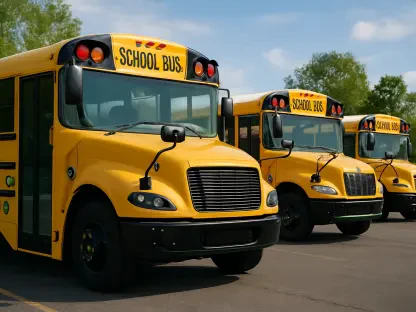The alarming decline in K-12 student performance across reading, math, and science has become a pressing concern for educators, policymakers, and families throughout the United States, as data reveals a troubling trend that predates and persists beyond the disruptions caused by the COVID-19 pandemic. Data from the National Assessment of Educational Progress (NAEP), widely regarded as the benchmark for tracking academic achievement, highlights this critical issue. This topic took center stage at a recent U.S. Senate Committee on Health, Education, Labor, and Pensions hearing, where experts and lawmakers grappled with the causes and potential remedies for these setbacks. The implications of this decline extend far beyond the classroom, threatening the nation’s future workforce readiness and economic competitiveness. As the evidence mounts, the urgency to understand and address the factors driving these declines grows, prompting a deeper exploration of systemic challenges, societal influences, and actionable solutions.
Unpacking the Alarming Data Trends
The NAEP results presented during the Senate hearing offer a stark illustration of the academic challenges facing American students. Between 2019 and 2024, eighth-graders experienced a 4-point drop in average science scores, while 12th-graders saw a 3-point decline in both math and reading over the same period. Even more troubling, only about one-third of 12th-graders were considered prepared for college-level math in 2024, a significant decrease from 37% five years prior. These figures indicate that student performance has yet to recover to pre-pandemic levels, raising serious concerns about long-term educational outcomes. The data serves as a critical alarm bell, signaling that without intervention, the gap between current achievement and necessary benchmarks for future success will continue to widen, impacting not just individual students but the broader societal fabric.
Beyond the raw numbers, the NAEP findings highlight disparities that demand attention. The consistent decline across multiple subjects and grade levels suggests that the problem is not isolated but systemic, affecting a broad swath of the student population. Lawmakers at the hearing emphasized that these trends could undermine the nation’s ability to compete globally, as proficiency in core subjects like math and science is essential for innovation and economic growth. The urgency to reverse this trajectory is palpable, yet the path forward remains unclear. Identifying the root causes behind these declines is a complex task, requiring a nuanced understanding of both educational policies and external influences that shape student learning environments. This data-driven insight sets the stage for a broader discussion on what is driving these setbacks and how they can be addressed effectively.
Exploring the Root Causes of Decline
During the Senate hearing, a range of perspectives emerged on why student performance is slipping. Committee Chair Sen. Bill Cassidy (R-Louisiana) argued that the issue lies not in the amount of funding allocated to education but in how resources are managed at state and local levels. His stance is that empowering communities to make decisions tailored to their unique needs could yield better results than top-down federal mandates. This viewpoint suggests that inefficiencies in resource allocation and a lack of localized innovation may be significant contributors to the current academic downturn. It also raises questions about whether the existing structure of educational governance is equipped to adapt to diverse regional challenges, pointing to a need for flexibility in policy implementation.
In contrast, Sen. Bernie Sanders (I-Vermont) framed the decline within a broader socioeconomic context, asserting that academic struggles are inseparable from the conditions in which students live. Factors such as poverty, food insecurity, and unstable family environments create formidable barriers to learning, often overshadowing efforts within schools. This perspective underscores the reality that many students arrive at school burdened by challenges far beyond the curriculum, making it difficult to focus on academic tasks. Addressing these external stressors requires a holistic approach that extends beyond traditional educational reforms to include social support systems. The divergence in these viewpoints highlights a fundamental debate: should the focus remain narrowly on schools, or must solutions encompass the wider societal issues impacting student well-being and readiness to learn?
Modern Distractions and Their Impact
Another dimension to the declining scores discussed at the hearing was the influence of modern technology on student focus. Martin West, vice chair of the National Assessment Governing Board, which oversees NAEP, suggested that the pervasive use of smartphones and social media might be diverting attention away from learning. Although direct causal links remain unproven, the correlation between increased screen time and reduced academic engagement is a growing concern. NAEP surveys further revealed a decline in recreational reading among students, a habit critical for building literacy skills. This shift in behavior points to a cultural change where digital distractions may be replacing activities that foster intellectual growth, posing a unique challenge for educators in today’s tech-saturated environment.
The potential impact of technology extends beyond mere distraction, influencing mental health and learning habits in ways that are still being understood. With students spending significant time on devices both inside and outside the classroom, the boundaries between educational tools and sources of interruption blur. This raises critical questions about how to integrate technology into education without allowing it to undermine focus and discipline. Schools face the dual task of leveraging digital resources for learning while mitigating their downsides, a balance that remains elusive. As research into these effects continues, it becomes clear that addressing the role of technology in education is not just about limiting screen time but about fostering a mindful approach to its use, ensuring it supports rather than hinders academic progress.
Lingering Effects of Past Disruptions
While the COVID-19 pandemic undeniably exacerbated educational challenges, the NAEP data spanning 2019 to 2024 indicates that the roots of the decline predate the crisis. School closures and the shift to remote learning disrupted traditional education, widening existing gaps in achievement, particularly for disadvantaged students. However, panelists at the hearing agreed that the pandemic alone does not account for the sustained downturn, pointing to deeper systemic flaws that have long plagued the education system. The consensus was that recovery efforts must go beyond simply restoring pre-pandemic norms and instead address chronic inequities that hinder student success across diverse demographics and regions.
This recognition of systemic issues underscores the complexity of the path forward. The lingering effects of disrupted learning environments have compounded pre-existing challenges, such as unequal access to resources and support. Targeted interventions are essential, but opinions differ on whether these should be driven by local innovation or bolstered by federal oversight. Some argue that state and community-led initiatives allow for more tailored solutions, while others stress that national support is crucial to level the playing field. Resolving these disparities requires a multifaceted strategy that acknowledges both the immediate impacts of recent disruptions and the entrenched structural barriers that continue to impede progress in K-12 education.
Pathways to Recovery and Reform
Amid the sobering statistics, the Senate hearing also spotlighted glimmers of hope through successful state-level initiatives. Indiana’s Secretary of Education, Katie Jenner, detailed how her state achieved a nearly 5-percentage-point increase in third-grade reading scores in just one year. This progress stemmed from a focused effort on evidence-based literacy programs, extensive teacher training, and public-private partnerships. Such results demonstrate the potential of localized, data-driven approaches to yield measurable improvements, aligning with the belief that states and communities can innovate effectively when given the autonomy to address their specific needs. These examples provide a blueprint for other regions seeking to reverse declining trends.
However, the hearing also revealed sharp policy divides that could impact recovery efforts. Sen. Patty Murray (D-Washington) expressed concern over federal education policies under the current administration, particularly cuts to funding and programs that support schools. She warned that such measures risk further derailing progress, leaving many institutions without the resources needed to implement reforms. This tension between federal involvement and local control remains a sticking point, with some lawmakers advocating for robust national support to tackle systemic inequities, while others prioritize state-led solutions. Bridging this gap will be crucial to ensure that promising initiatives can scale effectively, providing all students with the opportunity to succeed in an increasingly competitive world.
Building a Stronger Educational Future
Reflecting on the insights from the Senate hearing, it’s evident that the decline in K-12 academic performance has become a multifaceted crisis demanding urgent attention. The NAEP data has laid bare the extent of the challenge, with significant drops in core subjects signaling a gap in preparedness for future challenges. Discussions have pinpointed diverse causes, from socioeconomic barriers to technological distractions, while the lingering effects of past disruptions like the pandemic have added layers of complexity to the issue. The debate over solutions—whether rooted in local innovation or federal support—has underscored the difficulty of crafting a unified response to a problem with such varied dimensions.
Looking ahead, the path to improvement hinges on blending proven strategies with a commitment to addressing root causes. Policymakers should prioritize evidence-based reforms, drawing inspiration from state successes like Indiana’s literacy gains, while ensuring resources are available to tackle broader societal issues impacting students. Collaboration across state and federal levels could help balance autonomy with equity, creating a system where every child has access to quality education. By focusing on actionable, targeted interventions and fostering dialogue to resolve policy divides, the foundation for a stronger educational future can be laid, equipping the next generation for success.









